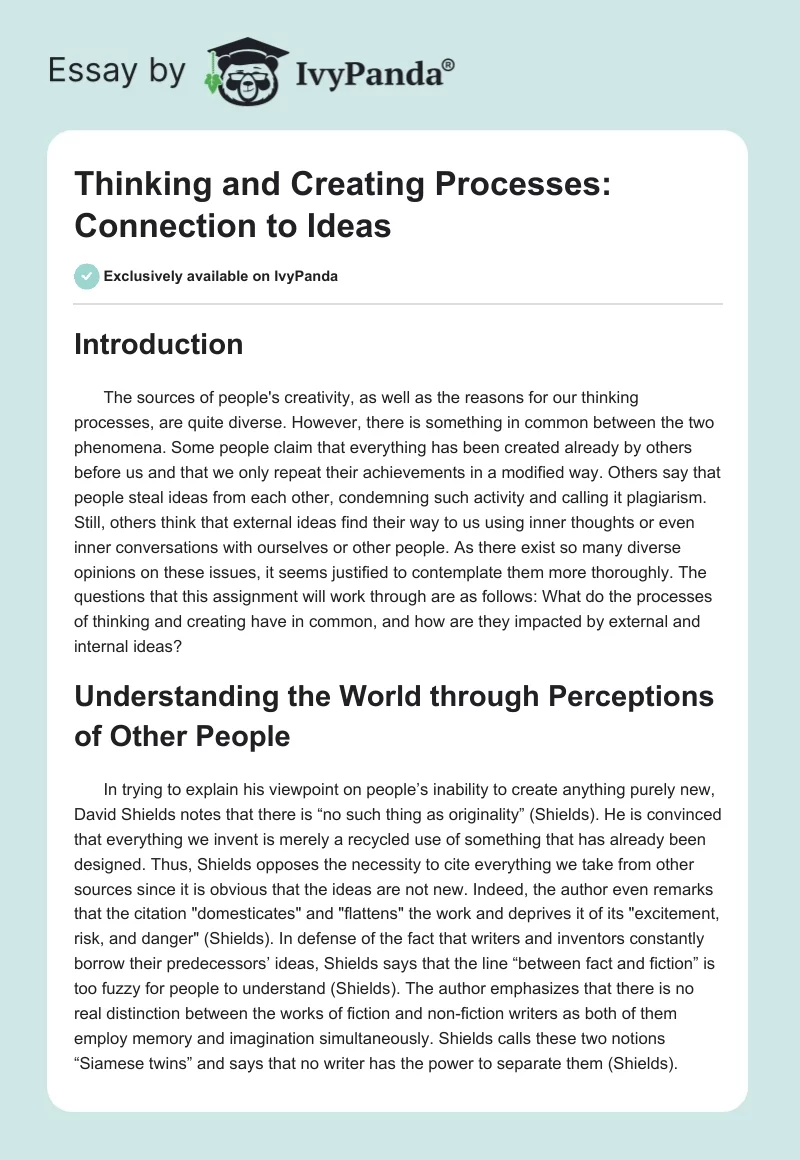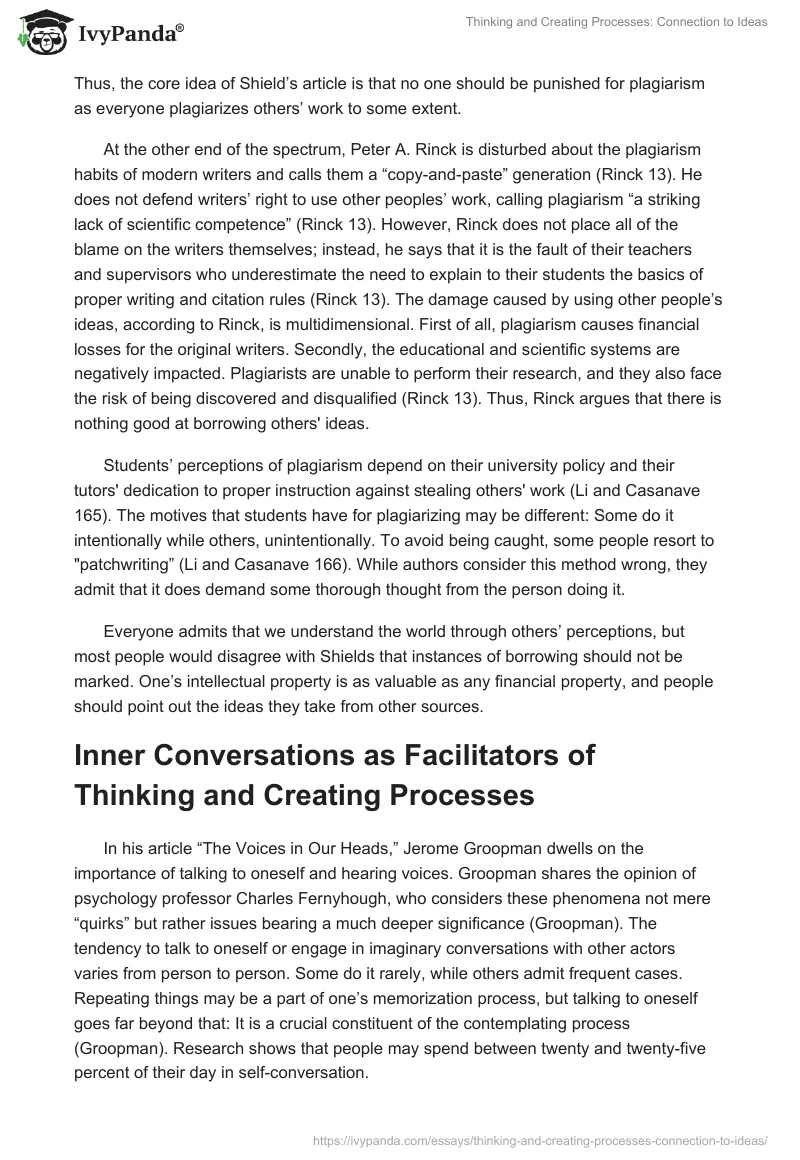Introduction
The sources of people’s creativity, as well as the reasons for our thinking processes, are quite diverse. However, there is something in common between the two phenomena. Some people claim that everything has been created already by others before us and that we only repeat their achievements in a modified way. Others say that people steal ideas from each other, condemning such activity and calling it plagiarism. Still, others think that external ideas find their way to us using inner thoughts or even inner conversations with ourselves or other people. As there exist so many diverse opinions on these issues, it seems justified to contemplate them more thoroughly. The questions that this assignment will work through are as follows: What do the processes of thinking and creating have in common, and how are they impacted by external and internal ideas?
Understanding the World through Perceptions of Other People
In trying to explain his viewpoint on people’s inability to create anything purely new, David Shields notes that there is “no such thing as originality” (Shields). He is convinced that everything we invent is merely a recycled use of something that has already been designed. Thus, Shields opposes the necessity to cite everything we take from other sources since it is obvious that the ideas are not new. Indeed, the author even remarks that the citation “domesticates” and “flattens” the work and deprives it of its “excitement, risk, and danger” (Shields). In defense of the fact that writers and inventors constantly borrow their predecessors’ ideas, Shields says that the line “between fact and fiction” is too fuzzy for people to understand (Shields). The author emphasizes that there is no real distinction between the works of fiction and non-fiction writers as both of them employ memory and imagination simultaneously. Shields calls these two notions “Siamese twins” and says that no writer has the power to separate them (Shields). Thus, the core idea of Shield’s article is that no one should be punished for plagiarism as everyone plagiarizes others’ work to some extent.
At the other end of the spectrum, Peter A. Rinck is disturbed about the plagiarism habits of modern writers and calls them a “copy-and-paste” generation (Rinck 13). He does not defend writers’ right to use other peoples’ work, calling plagiarism “a striking lack of scientific competence” (Rinck 13). However, Rinck does not place all of the blame on the writers themselves; instead, he says that it is the fault of their teachers and supervisors who underestimate the need to explain to their students the basics of proper writing and citation rules (Rinck 13). The damage caused by using other people’s ideas, according to Rinck, is multidimensional. First of all, plagiarism causes financial losses for the original writers. Secondly, the educational and scientific systems are negatively impacted. Plagiarists are unable to perform their research, and they also face the risk of being discovered and disqualified (Rinck 13). Thus, Rinck argues that there is nothing good at borrowing others’ ideas.
Students’ perceptions of plagiarism depend on their university policy and their tutors’ dedication to proper instruction against stealing others’ work (Li and Casanave 165). The motives that students have for plagiarizing may be different: Some do it intentionally while others, unintentionally. To avoid being caught, some people resort to “patchwriting” (Li and Casanave 166). While authors consider this method wrong, they admit that it does demand some thorough thought from the person doing it.
Everyone admits that we understand the world through others’ perceptions, but most people would disagree with Shields that instances of borrowing should not be marked. One’s intellectual property is as valuable as any financial property, and people should point out the ideas they take from other sources.
Inner Conversations as Facilitators of Thinking and Creating Processes
In his article “The Voices in Our Heads,” Jerome Groopman dwells on the importance of talking to oneself and hearing voices. Groopman shares the opinion of psychology professor Charles Fernyhough, who considers these phenomena not mere “quirks” but rather issues bearing a much deeper significance (Groopman). The tendency to talk to oneself or engage in imaginary conversations with other actors varies from person to person. Some do it rarely, while others admit frequent cases. Repeating things may be a part of one’s memorization process, but talking to oneself goes far beyond that: It is a crucial constituent of the contemplating process (Groopman). Research shows that people may spend between twenty and twenty-five percent of their day in self-conversation.
Unfortunately, no research or experiment can do more than give an unpolished phenomenology of our inner speech. Still, Fernyhough has managed to construct an impressive picture of inner speech. This process allows a person to participate in logical reasoning about what is right and what is wrong by building point-versus-counterpoint positions in his or her mind (Groopman). Furthermore, inner speech can perform the function of a safety mechanism. When a person talks to him or herself, he or she can more easily cope with negative feelings or emotions (Groopman). Such a defense mechanism of splitting one’s personality can be very effective in cases of dealing with past trauma. The core strategy of any cognitive-behavioral treatment presupposes that a person intentionally expresses thoughts to him or herself to eliminate “pernicious habits of mind” (Groopman). Thus, the importance of inner speech in dealing with various psychological disorders should not be underestimated.
The function of inner speech in cognitive operations has been the subject of research for many scholars. It has proved to play a highly beneficial role in the task-switching process and in problem-solving (Perrone-Bertolott et al. 230-231). Its assisting role in task-switching is explained by the ability of inner speech to act as a storage place for short-term memory. Participation in problem-solving is realized through the power of language to reinforce non-verbal cognition (Perrone-Bertolott et al. 230-231). Thus, inner speech plays a crucial role in people’s cognitive processes.
Conclusion
The thinking and creating abilities of every person differently, but they all share the need to be assisted to be the most productive. Whether it is the help of inner voices or inspiration from the work of others, we constantly use help to inspire us to create something new. Even if it is a modification of something old, every person’s creation deserves to be seen and heard. Opinions on paying tribute to the sources one uses are diverse. Some believe that we should not cite the works we use since everything has already been made before us, whereas others emphasize the importance of differentiating our thoughts from those we borrow. Regardless of one’s particular opinion, one thing is certain: No new idea would be possible without the experience of past achievements. We all base our creativity and thinking about something that has already been discovered, but we can make fantastic modifications to these discoveries.
Works Cited
Groopman, Jerome. “The Voices in Our Heads.” The New Yorker. 2017. Web.
Li, Yongyan, and Christine Pearson Casanave. “Two first-Year Students’ Strategies for Writing from Sources: Patchwriting or Plagiarism?” Journal of Second Language Writing, vol. 21, no. 1, 2012, pp. 165–180
Perrone-Bertolotti, Marcella, et al. “What Is That Little Voice Inside My Head? Inner Speech Phenomenology, Its Role in Cognitive Performance, and Its Relation to Self-Monitoring.” Behavioural Brain Research, vol. 261, 2014, pp. 220-239.
Rinck, Peter A. “The Copy-and-Paste Generation: Plagiarism’s Many Faces.” Rinckside, vol. 24, 2013, pp. 13-14.
Shields, David. “I Can’t Stop Thinking through what Other People Are Thinking.” The White Review. 2013. Web.


